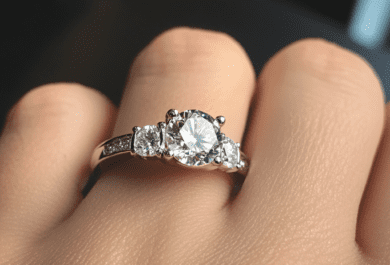The American Gem Society Lab (AGS) began proportion based Cut grading in 1996 (AGA started earlier) based on Tolkowsky‘ proportions. The top grade was AGS 0 and the worst was AGS 10. AGS 0’s cost as much as 10% more than same grade of GIA diamond; it was synonymous with “ideal cut”.
Diamonds with AGS 0 or ideal cut reports that were issued before 1st of June 2005 might not be considered to be AGS 0 under the new system, which is more like the HCA inverse crown and pavilion system. It uses light performance factors including software like DiamCalc, and the ASET scope, which is like a multi colored Ideal-Scope. Proportions are now only to guide to manufacturers and not the basis of grading. Stones must not breach certain ‘bad proportions’ and finish rules outlined below (this chart is indicative, but not the same as later AGS copyrighted versions).

Diamonds are rated for each of these criteria and the lowest score sets the final grade.
- Light Performance: Brightness, Fire (dispersion), Leakage and Contrast
- Proportion Factors: Girdle thickness, Culet size, Weight or Spread, Durability (no crown angles below 30°) and Tilt (fish-eye)
- Finish: Symmetry and Polish
1. Light Performance
Brightness: A high Light Return is required from a 3D scan of each diamond imported into the AGS version of DiamCalc.

Fire (Dispersion): AGS have designed their own Fire software that produces images like the one below. One day AGS might print Fire and ASET images (like the one in the DiamCalc simulation above) on certificates.

Leakage: AGS used a leakage calculation based on the older version of DiamCalc.
Contrast: We expect Contrast will be similar to DiamCalc. AGS’s new software does not work for all stones, so they will also use human grading based on ASET images.
2. Proportion Factors
Girdle thickness: Girdle thickness of all shapes of diamonds will now be measured at facet
junctions*, where the girdle is about 1.7% thicker than the scalloped valleys (where they were measured previously). AGS grades will be based on the percentages below.
| AGS Grade |
Description |
Girdle thickness for all shapes |
| 3 |
Ex Thin |
0 at any spot |
| 1 |
Very thin |
1.8–2.19% |
| 0 |
Thin |
2.2–2.99% |
| 0 |
Medium |
3.0–3.99% |
| 0 |
Slightly Thick |
4.0–4.99% |
| 3 |
Thick |
5.0–5.99% |
| 5 |
Very Thick |
6.0–6.99% |
| 7 |
Extremely Thick |
7.0–7.99% |
| 8 |
Extremely Thick |
8.0–8.99% |
| 9 |
Extremely Thick |
9.0–9.99% |
| 10 |
Extremely Thick |
> 10% |
|
Examples: |
| 3 |
Ex Thin-Med |
0–3.3% |
| 0 |
Thin-Slt Thick |
2.7–4.1% |
| 5 |
Med-Very Thick |
3.5–6.3% |
Culet size: AGS 0 – None to Medium, Slightly large – 2, Large – 5, Very Large – 9.
Spread: For rounds the DiamCalc factor should must be within + or -5% about 6.35 to 6.6mm for a 1.00ct stone. Princess spread factors should not be worse than -25, or about 5.3mm square.
Durability: No crown angles below 30° (rounds and princess)
Tilt (fish-eye): This is the amount of tilt to when you can see the girdle of a stone, from the face up position. The Fish-eye calculation on DiamCalc must be higher than 6°.
3. Finish: Symmetry and Polish
| AGS Finish Grades |
| Ideal |
0 |
| Excellent |
1 |
| Very Good |
2 |
| Good |
3, 4 |
| Fair |
5, 6, 7 |
| Poor |
8, 9, 10 |
AGS 0 Princess Cuts
AGS have a complex manufacturers guideline charts that show approximate table size and precise angles for pavilion 1, pavilion 2, crown 1, and crown 2 (which unfortunately are not given by Sarin and Ogi scanners).

Discuss on the Forum
Firescope & Ideal-Scope »















